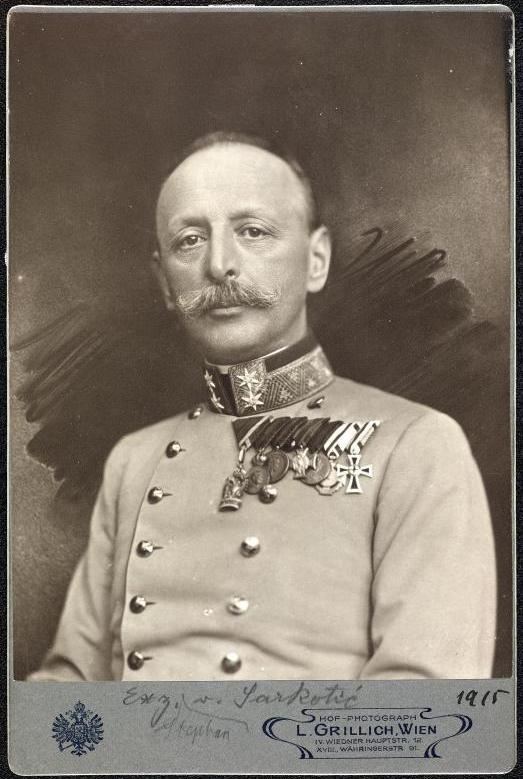Preceded by Oskar Potiorek Name Stjepan Sarkotic | Nationality Croat | |
 | ||
Appointed by Franz Joseph I of Austria Succeeded by Office abolished
(Atanasije Sola as President of the People's Government of Bosnia and Herzegovina) Born 4 October 1858
Sinac, Otocac, Austrian Empire ( 1858-10-04 ) Died 16 October 1939(1939-10-16) (aged 81)
Vienna, Nazi Germany Resting place Zentralfriedhof, Simmering, Vienna, Austria | ||
Stjepan Freiherr Sarkotic von Lovcen (also Stefan Sarkotic, Stjepan Sarkotic, or Stephan Sarkotic; 4 October 1858 – 16 October 1939) was an Austro-Hungarian Army general of Croatian ethnicity who served as Governor of Bosnia and Herzegovina during World War I.
Contents
Early life and education
Stjepan Sarkotic was born in Sinac near Otocac on 4 October 1858 as one of four siblings. His father was Lieutenant Matija Sarkotic of the Otocac Border Regiment Nr.2. After he attended gymnasium in Senj, he entered in Military School in Sankt Polten, and later he attended Theresian Military Academy in Wiener Neustadt.
Military career
In 1884 he got his first military post in the Koniggratz Regiment, and later he was transferred to 16th Infantry Regiment in Trebinje, Herzegovina. In 1886 he was stationed in Mostar in the 1. Mountain Brigade. Until 1887 he was involved in military actions that occurred in Bosnia and Herzegovina and in Krivosije in Montenegro. By 1889 he was promoted to the rank of captain and assigned to the General Staff Corps in Vienna. He was hereafter assigned to obtain intelligence on foreign nations. To this end he travelled abroad to Serbia, Bulgaria and Macedonia, Russian city Kazan, where he learned to speak Russian. After his return, he worked in Intelligence Service of General Staff, and after that he worked with troops in the field.
As soon as he became major, he was assigned to be commander of staff of the 7th Infantry Division in Osijek, where he remained for four years. After that, he was assigned to Regiment in Prague as lieutenant colonel. Between 1900 and 1903 he was chief of Staff at the port city of Pula during which time he became colonel in 1901. After his service in Pula, he was assigned to be commander of the staff of XII Corps in Sibiu in Transilvania. In 1907 he became commander of the 5th Infantry Brigade in Linz, and in the same year he was promoted to major general. In 1908 he became commander of the 88th Lands Rifle Regiment, and in 1910 he was assigned to be a commander of 44th Home Guard Division. On 2 November 1911 he was promoted to feldmarschalleutnant. Emperor Franz Joseph appointed him to the nobility in 1908.
On 10 April 1912 Sarkotic became general of the VI Royal Hungarian Honved District, succeeding his countryman Svetozar Boroevic in this post. Sarkotic was also commander of the Home Guard of the Kingdom of Croatia-Slavonia with headquarters in Zagreb.
Governor of Bosnia and Herzegovina
With the start of World War I, Sarkotic was one of the chief commanders of Austrian forces on the Serbian campaign. He handled his duties well despite overall setbacks on the part of the Austrians. In 1914 he was made Knight 2nd Class of the Order of the Iron Crown. He was also soon made the commanding general in Bosnia and Herzegovina, succeeding Oskar Potiorek. As governor of Bosnia and Herzegovina he understood the need for reforms in the region by both Austria and Hungary due to what he saw as the danger of a Yugoslav state.
In 1916 Sarkotic commanded the Western wing of the campaign into Montenegro from the naval base in Kotor. His troops attacked the Montenegrin forces at Mount Lovcen. Within two days his forces took Lovcen and three days after that the Montenegrin capital, Cetinje, was also under their control. For the success of this operation, Sarkotic was awarded the Order of Leopold First Class with War Decoration and Swords and the Bronze Military Merit Medal with Swords. He was also made a Hungarian baron, accepting the style of von Lovcen, and was afterwards officially styled Stefan Baron Sarkotic von Lovcen at the Austrian court. Although his title of baron was Hungarian, Sarkotic was often referred to as Freiherr Sarkotic von Lovcen in German.
In 1917 he was promoted to Generaloberst (Colonel General). He continued at his position in Bosnia and Herzegovina until 1918. With the dissolution of the Dual Monarchy, he retired in December 1918. However, Sarkotic was incarcerated by officials from the newly proclaimed Kingdom of Serbs, Croats and Slovenes along with other political opponents of the state. Sarkotic was strongly anti-Serbian and anti-Yugoslav. During his tenure as governor of Bosnia and Herzegovina he suggested the unification of Croatia-Slavonia with Dalmatia and Bosnia and Herzegovina. However, Austria-Hungary's political elite never took the threat of a South Slav state very seriously. Istvan Tisza, Prime Minister of Hungary suggested a plebiscite be held, but the actions were too little too late. On Sarkotic's recommendation Tisza met with Ivo Pilar and Josip Vancas, anti-Yugoslav members of the Croat People's Union in the Diet of Bosnia and Herzegovina, during his visit to Sarajevo in September 1918.
Emigration
After his release he returned to Vienna. Here he was involved with Croatian emigrant and resistant groups. He frequently wrote against the ruling Serb Karadordevic dynasty in the Austrian Reichspost. He also formed and was head of a group known as the Croatian Committee (as opposed to the Yugoslav Committee) which he led until January 1929, when Ante Pavelic replaced him. Sarkotic's exile from his homeland lasted the rest of his life. He died in Vienna in 1939 and was buried in a vault at the Zentralfriedhof.
